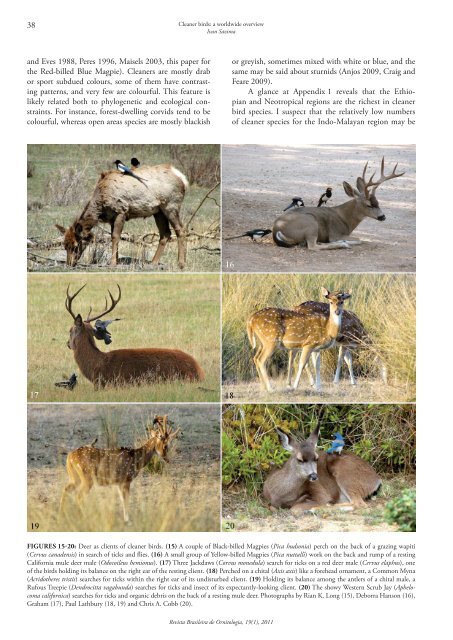Capa 19(1) - fechada.indd - Sociedade Brasileira de Ornitologia
Capa 19(1) - fechada.indd - Sociedade Brasileira de Ornitologia
Capa 19(1) - fechada.indd - Sociedade Brasileira de Ornitologia
Create successful ePaper yourself
Turn your PDF publications into a flip-book with our unique Google optimized e-Paper software.
38 Cleaner birds: a worldwi<strong>de</strong> overview<br />
Ivan Sazima<br />
and Eves <strong>19</strong>88, Peres <strong>19</strong>96, Maisels 2003, this paper for<br />
the Red-billed Blue Magpie). Cleaners are mostly drab<br />
or sport subdued colours, some of them have contrasting<br />
patterns, and very few are colourful. This feature is<br />
likely related both to phylogenetic and ecological constraints.<br />
For instance, forest-dwelling corvids tend to be<br />
colourful, whereas open areas species are mostly blackish<br />
or greyish, sometimes mixed with white or blue, and the<br />
same may be said about sturnids (Anjos 2009, Craig and<br />
Feare 2009).<br />
A glance at Appendix 1 reveals that the Ethiopian<br />
and Neotropical regions are the richest in cleaner<br />
bird species. I suspect that the relatively low numbers<br />
of cleaner species for the Indo-Malayan region may be<br />
Figures 15‐20: Deer as clients of cleaner birds. (15) A couple of Black-billed Magpies (Pica hudsonia) perch on the back of a grazing wapiti<br />
(Cervus cana<strong>de</strong>nsis) in search of ticks and flies. (16) A small group of Yellow-billed Magpies (Pica nuttalli) work on the back and rump of a resting<br />
California mule <strong>de</strong>er male (Odocoileus hemionus). (17) Three Jackdaws (Corvus monedula) search for ticks on a red <strong>de</strong>er male (Cervus elaphus), one<br />
of the birds holding its balance on the right ear of the resting client. (18) Perched on a chital (Axis axis) like a forehead ornament, a Common Myna<br />
(Acridotheres tristis) searches for ticks within the right ear of its undisturbed client. (<strong>19</strong>) Holding its balance among the antlers of a chital male, a<br />
Rufous Treepie (Dendrocitta vagabunda) searches for ticks and insect of its expectantly-looking client. (20) The showy Western Scrub Jay (Aphelocoma<br />
californica) searches for ticks and organic <strong>de</strong>bris on the back of a resting mule <strong>de</strong>er. Photographs by Rian K. Long (15), Deborra Hanson (16),<br />
Graham (17), Paul Lathbury (18, <strong>19</strong>) and Chris A. Cobb (20).<br />
Revista <strong>Brasileira</strong> <strong>de</strong> <strong>Ornitologia</strong>, <strong>19</strong>(1), 2011

















